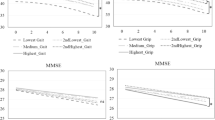Abstract
Objective
Impairment of physical performance might identify older people at higher risk of dementia over time. The present study evaluated handgrip strength as independent predictor of cognitive decline.
Design
Observational, prospective. Follow-up duration: 11.2 ± 0.8 months.
Setting and participants
Geriatric outpatients center. 104 consecutive stroke- and dementia-free older adults (44% men, ages 80.2±5.4 years).
Methods
The Clinical Dementia Rating scale and the Clock Drawing Test (CDT) were administered. Handgrip strength was assessed using a Jamar hand dynamometer. Brain magnetic resonance imaging studies at 1.5 T were performed. White matter damage was expressed as severity of white matter hyperintensities (WMHs). Longitudinal changes in cognitive function were expressed as 1-year decline in CDT performance.
Results
A robust association was observed between baseline handgrip strength and 1-year cognitive decline after multiple adjustment. Of note, the strength of such association was only minimally attenuated after adjusting for deep WMHs extent (β coefficient for handgrip strength = 0.183, SE= 0.038, p= 0.007, R2= 0.58).
Conclusions
Handgrip strength predicted accelerated 1-year decline in cognitive function, assessed by CDT, in a sample of older adults. Future studies are needed to elucidate the causal mechanisms linking limitations in physical function with dementia risk.



Similar content being viewed by others
References
Verghese J, Wang C, Lipton RB, et al. Motoric cognitive risk syndrome and the risk of dementia. J Gerontol A Biol Sci Med Sci 2013;68:412–8.
Taekema DG, Gussekloo J, Maier AB, et al. Handgrip strength as a predictor of functional, psychological and social health. A prospective population-based study among the oldest old. Age Ageing 2010;39:331–7.
Giampaoli S, Ferrucci L, Cecchi F, et al. Hand-grip strength predicts incident disability in non-disabled older men. Age Ageing 1999;28:283–8.
Alfaro-Acha A, Snih SA, Raji MA, et al. Handgrip strength and cognitive decline in older Mexican Americans. J Gerontol A Biol Sci Med Sci 2006;61:859–65.
Buchman AS, Wilson RS, Boyle PA, et al. Grip strength and the risk of incident Alzheimer’s disease. Neuroepidemiology 2007;29:66–73.
Boyle PA, Buchman AS, Wilson RS, et al. Association of muscle strength with the risk of Alzheimer disease and the rate of cognitive decline in community-dwelling older persons. Arch Neurol 2009;66:1339–44.
American Psychiatric Association. Diagnostic and Statistical Manual of Mental Disorders, Fourth edn. Text Revision. American Psychiatric Association, Washington, DC, 2000.
O’Bryant SE, Waring SC, Cullum CM, et al. Staging dementia using Clinical Dementia Rating Scale Sum of Boxes score: A Texas Alzheimer’s research consortium study. Arch Neurol 2008;65:1091–95.
Mahoney FI, Barthel DW. Functional evaluation: the Barthel Index. Md State Med J 1965;14:61–5.
Fazekas F, Chawluk JB, Alavi A, et al. MR signaling abnormalities at 1.5 T in Alzheimer’s dementia and normal aging. AJR Am J Roentgenol 1987;149:351–6.
Sunderland T, Hill JL, Mellow AM, et al. Clock drawing in Alzheimer’s disease: a novel measure of dementia severity. J Am Geriatr Soc 1989;37:725–9.
Christensen H, Mackinnon AJ, Korten A, Jorm AF. The “common cause hypothesis” of cognitive aging: evidence for not only a common factor but also specific associations of age with vision and grip strength in a cross-sectional analysis. Psychol Aging 2001;16:588–99.
Tan ZS, Beiser AS, Fox CS, et al. Association of metabolic dysregulation with volumetric brain magnetic resonance imaging and cognitive markers of subclinical brain aging in middle-aged adults. Diabetes Care 2011;34:1766–70.
Price TR, Manolio TA, Kronmal RA, et al. Silent brain infarction on magnetic resonance imaging and neurological abnormalities in community-dwelling older adults. The Cardiovascular Health Study. CHS Collaborative Research Group. Stroke 1997;28:1158–64.
Fjell AM, Walhovd KB. Structural brain changes in aging: courses, causes and cognitive consequences. Rev Neurosci 2010;21:187–21.
Taekema DG, Ling CHY, Kurrle SE, et al. Temporal relationship between handgrip strength and cognitive performance in oldest old people. Age Ageing 2012;41:506–12.
Cesari M, Penninx BW, Pahor M, et al. Inflammatory markers and physical performance in older persons: The InCHIANTI Study. J Gerontol A Med Sci Biol Sci 2004;59:242–8.
Viscogliosi G, Marigliano V. Alzheimer’s disease: how far have we progressed? Lessons learned from diabetes mellitus, metabolic syndrome, and inflammation. J Am Geriatr Soc 2013;61:845–6.
Ogata S, Kato K, Honda C, et al. Common genetic factors influence hand strength, processing speed, and working memory. J Epidemiol 2014;24:31–8.
Tay L, Lim WS, Chan M, et al. The independent role of inflammation in physical frailty among older adults with mild cognitive impairment and mild-to-moderate Alzheimer’s disease. J Nutr Health Aging 2016;20:288–99.
Fitten LJ. Thinking about cognitive frailty. J Prev Alz Dis 2015;2:7–10.
Author information
Authors and Affiliations
Corresponding author
Rights and permissions
About this article
Cite this article
Viscogliosi, G., di Bernardo, M.G., Ettorre, E. et al. Handgrip strength predicts longitudinal changes in clock drawing test performance. An observational study in a sample of older non-demented adults. J Nutr Health Aging 21, 593–596 (2017). https://doi.org/10.1007/s12603-016-0816-9
Received:
Accepted:
Published:
Issue Date:
DOI: https://doi.org/10.1007/s12603-016-0816-9




